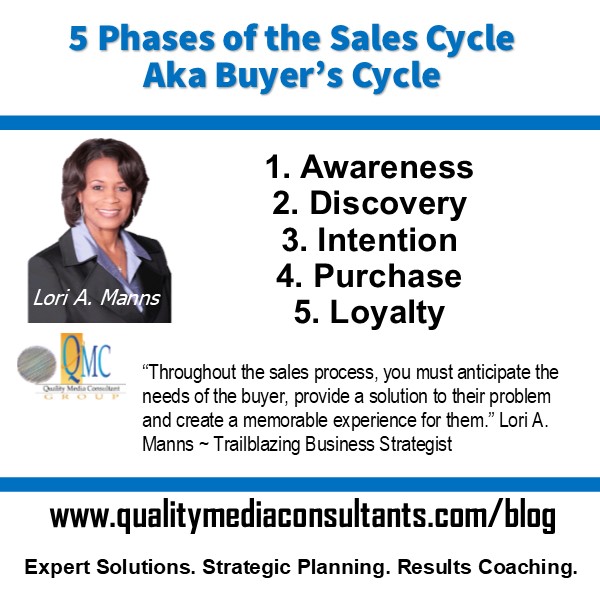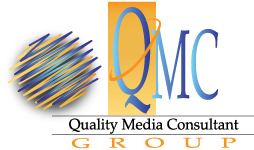
Navigating the buyer’s cycle effectively will result in happy clients and more revenue for your business.
In the sales process there is something called the buyer’s cycle or sales cycle which involves the prospect (buyer) moving from a lead to a paying customer. In each phase of the cycle, as the seller, you must be prepared to deal with the prospective buyer in different ways so you can guide them along the sales process and convert them into a paying client. In each phase of the cycle, there are certain actions that must be taken to in order to navigate the process effectively. This article looks at the different stages a prospective buyer reaches as they matriculate through your your sales funnel. In addition, we will cover specific and necessary actions you must take (as the seller) to optimize the process and convert them into a paying client efficiently and effectively.
Here are the 5 Phases of the Buyer’s cycle aka the Sales cycle and the actions needed by you (the seller).
Awareness Phase – This is when a prospect first becomes aware of your product or service. At this time the prospect is just browsing so to speak. They may or may not be in the market to buy at that time. However, they have newly discovered your product or service and have some idea that you exist. In this phase if you attempt to sell the prospect, you will likely turn them off.
Think of it this way…it’s a shopping experience. Picture the last time you went to a shopping mall, you may have casually walked in a department store to window shop. You may not have been looking for anything in particular, so you were planning to browse all by your lonesome, in peace. Can you imagine a salesperson coming over to greet you and badgering you about what brought you in the store? It would be a horrible experience if they were aggressively trying to show you new merchandise and/or convince you to purchase something that you did not want or need. You would have probably quickly walked out of the store or politely said, “I’m just browsing,” in hopes that they would leave you alone.
The above scenario is how people feel when they meet you for the first time and you instantly are trying to pitch your products and services, and “sell them.” There are people who do this online and offline. I call it gorilla selling. No one wants someone breathing down their back trying to sell them something. Can you picture a hungry gorilla breathing down your back ready to make you his next conquest? Not a pretty picture, huh? Don’t be like the hungry gorilla!
Actions Needed:
Give your capability statement. Demonstrate your ability to address a specific need or solve a problem for the prospect, should the opportunity present itself. You never know, down the road, they become ready to buy.
Discovery Phase – This is the period of time when the prospect is researching buying options and attempting to determine what to buy or who to hire. At this stage in the process, the prospect is probably researching options both online and offline. They may even be asking their friends, family or business colleagues for referrals and recommendations.
During this phase you must understand that different lead sources produce different types of buyers. At different times in the discovery phase there are triggers that may spark a prospect to move along the process faster. Remember, they are considering their options.
A trigger is anything that caused a buyer to have a clear need that they must address which gives them a sense of purpose. There are two types of buyers that each have different triggers: early cycle buyers and late cycle buyers.
Early cycle buyers: For example: leads that come from online sources such as: Facebook, Twitter, Instagram, or other general awareness platforms, may produce people who are just becoming aware of your company, so they are in the early stages of the sales cycle. Their triggers can be any information that causes them to consider the purchase of something they are interested in. Examples of this could include the fact that you had an interest in bicycles and although you had not actively priced them or began looking for them, you see an ad that catches your eye so you decide to check it out.
Late cycle buyers: For example: leads that come from Internet search engines such as: Google, Yahoo or Bing, are most likely closer to the decision to buy because they are actively searching for a solution to a specific problem or need. Examples of this would be: someone searching for a plumber because they have a leak in the basement; or someone searching for a new security system because they recently experienced a burglary.
Actions Needed:
Provide your unique selling proposition. Clarify your messaging for the buyer. Remember at this point they are a prospective client who may be triggered to make a purchase, sooner rather than later. Your messaging should hit the nail on the head to let them know why they should purchase your item instead of your competitors.
Intention Phase – This is the period of time in which the prospect has decided they are going to buy. They may have actually began the plans of buying i.e., getting quotes and shopping around. At this time, the prospect is in comparing prices and analyzing each option ahead of them. This is also the time when the negotiation phase begins. The buyer may have notified the seller that he or she will be making a purchase at a future time and inquires about price. The buyer is letting the seller know that he or she is “in the market” to buy xyz product or service.
Once the prospect has made the decision to buy a particular product or service, the process can go either go very fast or very slow. If the buyer is determined and motivated, the process moves quickly. If the buyer is not in a hurry, or is undecided, the process may take a long time. Typically somewhere in the intention phase, the buyer makes a selection about their service provider and knows who they are planning to buy from. However, although they are mostly convinced they are going to make a purchase., they have not made a purchase yet. In this phase the prospect is actively seeking confirmation that if they make a purchase from your company, it will be the right choice. They are looking for validation to buy from you and not your competitor.
Actions needed:
Nurture the prospect by staying in touch and providing any information that will motivate them to make a buying decision. Assure the prospect that they are making the right choice if they buy from you. Be sure to introduce them to your core marketing message. Reinforce your unique selling proposition. Tell them why you or your product is unique, better and different.
Purchase Phase – The phase in which the prospect makes a purchase and becomes a paying client. This is the closing of the sale. The transaction is complete. The contract is signed. The deal is done. It’s your job to reassure the client that they made the right choice. You must win the client over until they become a raving fan by providing them with the best possible experience you can offer.
Actions Needed:
Provide excellent customer service. Make sure to satisfy the needs of the client so that they are satisfied with their purchase. The last thing you want is for the buyer to experience buyers remorse. Your job is to make them happy.
Loyalty Phase – This is the phase where the client has bought the product or service from the seller and is seeking added value items as well as a superb client experience. The client wants to have a pleasant experience and when they do, 9 times out of 10, they are willing to write a great testimonial.
Actions needed:
During this phase, as the seller, your job is to turn the buyer into a loyal, repeat customer so that they are willing to continue buying from you as well as refer other people to you.
As you can see, the sales cycle for buyer and sellers, can be a pretty lengthy and intense process. Through every phase, your job as the provider (seller) is to make sure the prospect (buyer) has a memorable experience until and well after they become a client. Happy buyers become repeat customers/clients and that’s what every business owner should strive to have more of.
Want to use this article on your blog or website? Here’s the author’s box you must include.
© 2019 All Rights Reserved Quality Media Consultant Group
This article was written by Lori A. Manns.
Author, Lori A. Manns is a multi award-winning marketing mentor, sales coach and trailblazing business strategist who works with small business owners and entrepreneurs to help them grow and scale their businesses. She specializes in sales and marketing strategies that result in her clients attracting their target market, gaining brand visibility and growing revenue. Lori is President of Quality Media Consultant Group, a consultancy firm specializing in media, advertising, marketing and sales. She is the founder of the Trailblazer Business Academy. where advancing entrepreneurs go to learn growth strategies and how to run a profitable business the soulful way. Lori is also the creator of the Sponsorship Sales Secrets System;™ which shows business owners how to get more corporate sponsors and sales for their business, guaranteed. To learn more about the work Lori does to help business owners and entrepreneurs all across the U.S. to accelerate their revenue and succeed in business, visit www.qualitymediaconsultants.com
© 2019 All Rights Reserved Quality Media Consultant Group
